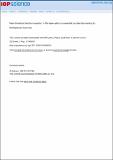Files in this item
Near-threshold electron injection in the laser-plasma wakefield accelerator leading to femtosecond bunches
Item metadata
| dc.contributor.author | Islam, M.R. | |
| dc.contributor.author | Brunetti, E. | |
| dc.contributor.author | Shanks, R.P. | |
| dc.contributor.author | Ersfeld, B. | |
| dc.contributor.author | Issac, R.C. | |
| dc.contributor.author | Cipiccia, S. | |
| dc.contributor.author | Anania, M.P. | |
| dc.contributor.author | Welsh, G.H. | |
| dc.contributor.author | Wiggins, S.M. | |
| dc.contributor.author | Noble, A. | |
| dc.contributor.author | Cairns, R Alan | |
| dc.contributor.author | Raj, G. | |
| dc.contributor.author | Jaroszynski, D.A. | |
| dc.date.accessioned | 2015-11-06T11:40:05Z | |
| dc.date.available | 2015-11-06T11:40:05Z | |
| dc.date.issued | 2015-09-17 | |
| dc.identifier | 228910769 | |
| dc.identifier | bb0deee5-6a75-4443-9359-c91b2fb86b3e | |
| dc.identifier | 84943523413 | |
| dc.identifier | 000367362500006 | |
| dc.identifier.citation | Islam , M R , Brunetti , E , Shanks , R P , Ersfeld , B , Issac , R C , Cipiccia , S , Anania , M P , Welsh , G H , Wiggins , S M , Noble , A , Cairns , R A , Raj , G & Jaroszynski , D A 2015 , ' Near-threshold electron injection in the laser-plasma wakefield accelerator leading to femtosecond bunches ' , New Journal of Physics , vol. 17 . https://doi.org/10.1088/1367-2630/17/9/093033 | en |
| dc.identifier.issn | 1367-2630 | |
| dc.identifier.uri | https://hdl.handle.net/10023/7750 | |
| dc.description | We gratefully acknowledge the support of the UK EPSRC (grant no. EP/J018171/1), the EU FP7 programmes: the Extreme Light Infrastructure (ELI) project, the Laserlab-Europe (no. 284464), and the EUCARD-2 project (no. 312453). | en |
| dc.description.abstract | The laser-plasma wakefield accelerator is a compact source of high brightness, ultra-short duration electron bunches. Self-injection occurs when electrons from the background plasma gain sufficient momentum at the back of the bubble-shaped accelerating structure to experience sustained acceleration. The shortest duration and highest brightness electron bunches result from self-injection close to the threshold for injection. Here we show that in this case injection is due to the localized charge density build-up in the sheath crossing region at the rear of the bubble, which has the effect of increasing the accelerating potential to above a critical value. Bunch duration is determined by the dwell time above this critical value, which explains why single or multiple ultra-short electron bunches with little dark current are formed in the first bubble. We confirm experimentally, using coherent optical transition radiation measurements, that single or multiple bunches with femtosecond duration and peak currents of several kiloAmpere, and femtosecond intervals between bunches, emerge from the accelerator. | |
| dc.format.extent | 1799450 | |
| dc.language.iso | eng | |
| dc.relation.ispartof | New Journal of Physics | en |
| dc.subject | QC Physics | en |
| dc.subject | DAS | en |
| dc.subject.lcc | QC | en |
| dc.title | Near-threshold electron injection in the laser-plasma wakefield accelerator leading to femtosecond bunches | en |
| dc.type | Journal article | en |
| dc.contributor.sponsor | EPSRC | en |
| dc.contributor.institution | University of St Andrews. Applied Mathematics | en |
| dc.contributor.institution | University of St Andrews. Pure Mathematics | en |
| dc.identifier.doi | 10.1088/1367-2630/17/9/093033 | |
| dc.description.status | Peer reviewed | en |
| dc.identifier.grantnumber | EP/J018171/1 | en |
This item appears in the following Collection(s)
Items in the St Andrews Research Repository are protected by copyright, with all rights reserved, unless otherwise indicated.

